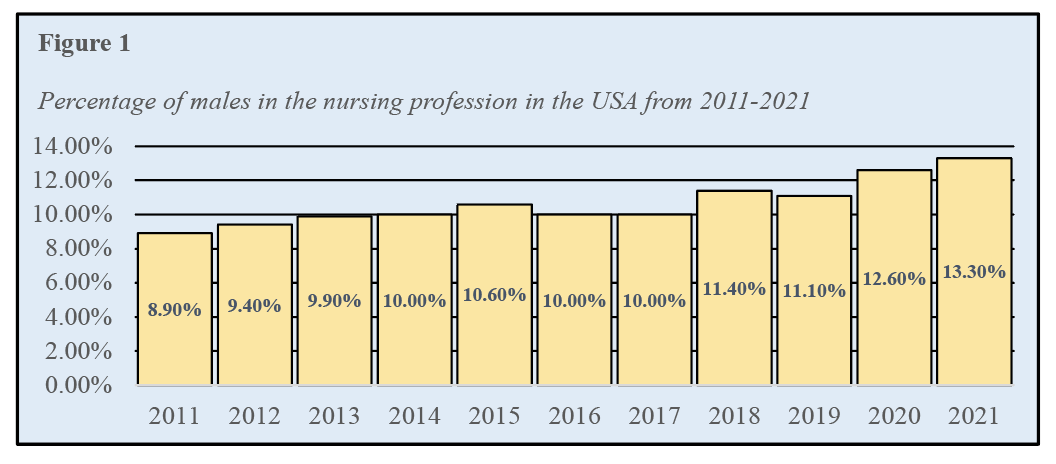
5 minute read
Diversity, Equity And Inclusion
Gender Equality in Nursing
By Jeffrey Williams, DNP, APRN, CCNS, CCRN and Michael Ward, MSN, APRN, AGACNP-BC
BACKGROUND
The healthcare system relies heavily on nursing, which constitutes the largest sector of healthcare workers globally. Nurses spend the most time with patients and play a crucial role in patient care. Therefore, promoting diversity, equity, and inclusion (DEI) within nursing is imperative for healthcare facilities and systems. DEI has gained considerable attention in recent years, and understanding its conceptual foundations is essential. Diversity encompasses differences such as gender, race, ethnicity, language, age, religion, sexual orientation, gender identity, or political perspective. Equity emphasizes promoting justice and fairness in resource distribution. Inclusion ensures that diverse individuals feel safe and welcomed in their environments (Heinz, 2024).
One aspect of this DEI within nursing is the male nurse. The data shows an increase in the percentage of male nurses from 8.9% in 2011 to 13.3% in 2021. (Johnson, 2022). (See figure 1)

The global data on the number of males in nursing for select countries can be seen in figure 2 (World Health Organization, 2022).

Why is it that males are not flocking to nursing as a professional career option? There are likely several factors that play a role in the lack of males entering the nursing profession. These barriers include stereotypes (gender, racial and ethnic) and biases. A stereotype is a widely held and oversimplified image or idea of a particular person or thing (APA, 2018). Some of the stereotypes that often arise for male nurses include that all male nurses are homosexual, nursing is viewed as a feminine profession and black male nurses being mistaken for environmental service staff (Smith et al., 2021). Biases play a role in hindering not only client care, but the idea of males becoming nurses. Implicit bias is a form of bias that occurs automatically and unintentionally, that nevertheless affects judgements, decisions and behaviors (Payne, Niemi & Doris, 2018). When a person understands their own biases they can start to remove those biases and learn to embrace the differences that make the world so diverse.

INTERVENTION/APPROACH
The project aimed to break down barriers and develop an effective plan to increase male participation in nursing over the next 5 to 10 years. Breaking down barriers to male entry into nursing is essential for increasing their representation in the profession. The project explored various recruitment methods, such as initiating discussions about nursing in middle schools, emphasizing the impact nurses make and the stability of the profession. Personal interactions with male nurses were proposed to foster positive perceptions of the nursing role (Noordien, Hoffman and Julie, 2020). Another strategy involved leveraging campaigns like the American Association for Men in Nursing’s ‘Engaging the Future RN’ to reach young men across all geographic regions of America and inspire them to pursue nursing careers (AAMN, 2019). One aspect of this campaign utilizes local AAMN chapters to present and introduce information on the nursing profession to both middle and high school students. Discussing nursing roles and opportunities with middle and high school students can spark interest in nursing careers.
CONCLUSIONS/ IMPLICATIONS FOR PRACTICE
Implementing strategies that can help break down the barriers and decrease the biases related to the idea of males entering the nursing profession will have a positive impact on healthcare. These impacts will have a lasting effect on the nursing profession. Males are the untapped potential that can make a great and lasting impact on the nursing profession. The number of males entering the nursing profession has not grown substantially over the last 40 years. Increasing the diversity, equity and inclusion within the nursing profession will have positive impacts within healthcare. More males in nursing would help lessen the nursing shortage and help to mirror the populations that nursing serves.
The nursing shortage is projected to reach 3.5 million by 2030 (United States DHHS, 2017). Encouraging more males to join the nursing profession could mitigate this shortfall over the next 7-10 years (Johnson, 2022). A higher representation of males in nursing would better align with the demographic of male patients seeking care. This could lead to increased client satisfaction, improved communication between male patients and their providers, and ultimately, enhanced health outcomes for men.
For more information on the American Association for Men in Nursing, visit AAMN.org.
Jeffrey Williams, DNP, APRN, CCNS, CCRN is an associate clinical professor at Texas Woman’s University College of Nursing in Dallas, Texas. Michael Ward, MSN, APRN, AGACNP-BC is chief clinical officer at NextLevelTRT.com and ICU intensivist with Advent Health in Fort Worth, Texas.
REFERENCES
American Association for Men in Nursing. (2019). Men in nursing brochure. Retrieved from https://www. aamn.org/_files/ugd/0fcc5e_9cd95c2102784584ac151 5a51cc4743b.pdf
American Psychological Association. (2018). APA Dictionary of Psychology, Stereotype April 18, 2019. Retrieved from https://dictionary.apa.org/stereotype Heinz, K. (2024). What does DEI mean in the workplace? March 5, 2024. Retrieved from https:// builtin.com/diversity-inclusion/what-does-dei-meanin-the-workplace
Johnson, S. (2022). Amid Shortages and Burnout, Could Adding More Men Ease the Nation’s Nursing Woes? April 28, 2022. Retrieved from https://www. usnews.com/news/health-news/articles/2022-04-28/ could-adding-more-men-help-solve-the-nationsnursing-woes
Noordien, I., Hoffman, J. and Julie, H. (2020). Male students’ motivations to choose nursing as a career. African Journal of Health Professions Education, 12(4), 220-223. doi: 10.7196/AJHPE.2020.v12i4.1371
Payne, K., Niemi, L. and Doris, J. (2018). How to think about ‘Implicit Bias’. March 27, 2028. Retrieved from https://www.scientificamerican.com/article/how-tothink-about-implicit-bias/
Smith, B., Rojo, J., Everett, B, Montayre, J., & Sierra, J. (2021). Professional success of men in the nursing workforce: An integrative review. Journal of Nursing Management, 29, 2470-2488.
United States Department of Health and Human Services. (2017). Supply and Demand Projections of the Nursing Workforce: 2014-2030. July 21, 2017. Retrieved from https://bhw.hrsa.gov/sites/default/files/ bureau-health-workforce/data-research/nchwa-hrsanursing-report.pdf
World Health Organization. (2022). National Health Workforce Accounts. Data Portal: Occupation Profile. Retrieved from https://apps.who.int/nhwaportal/ Home/Index










